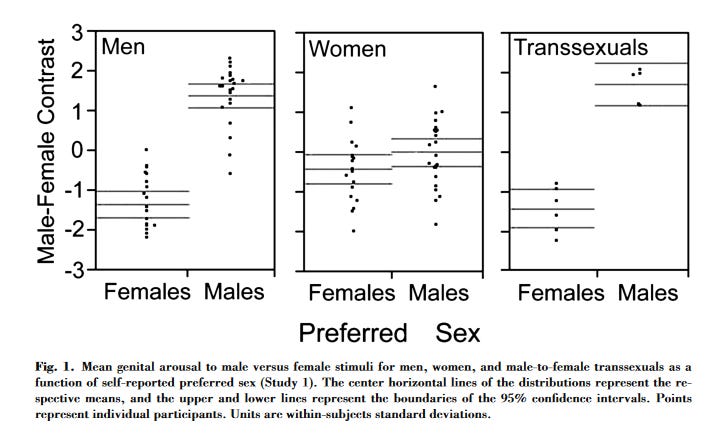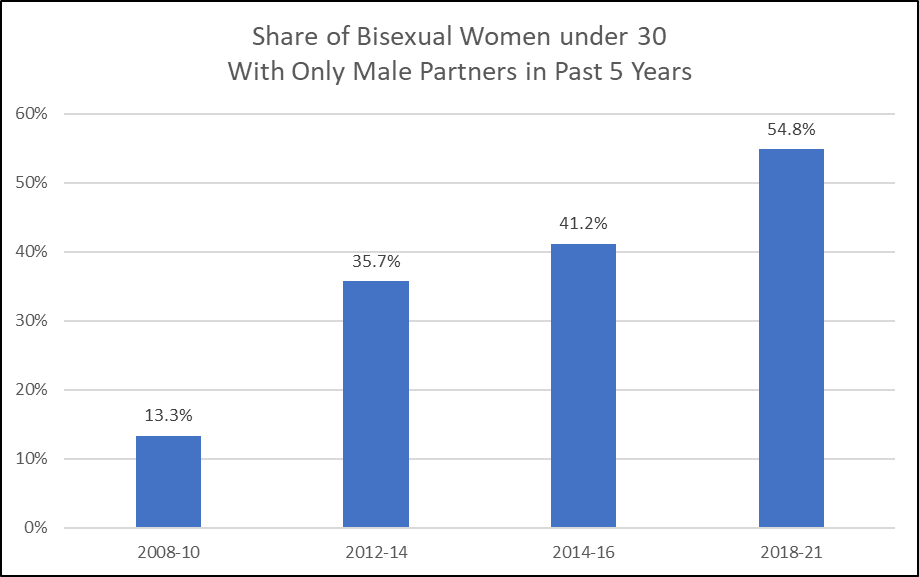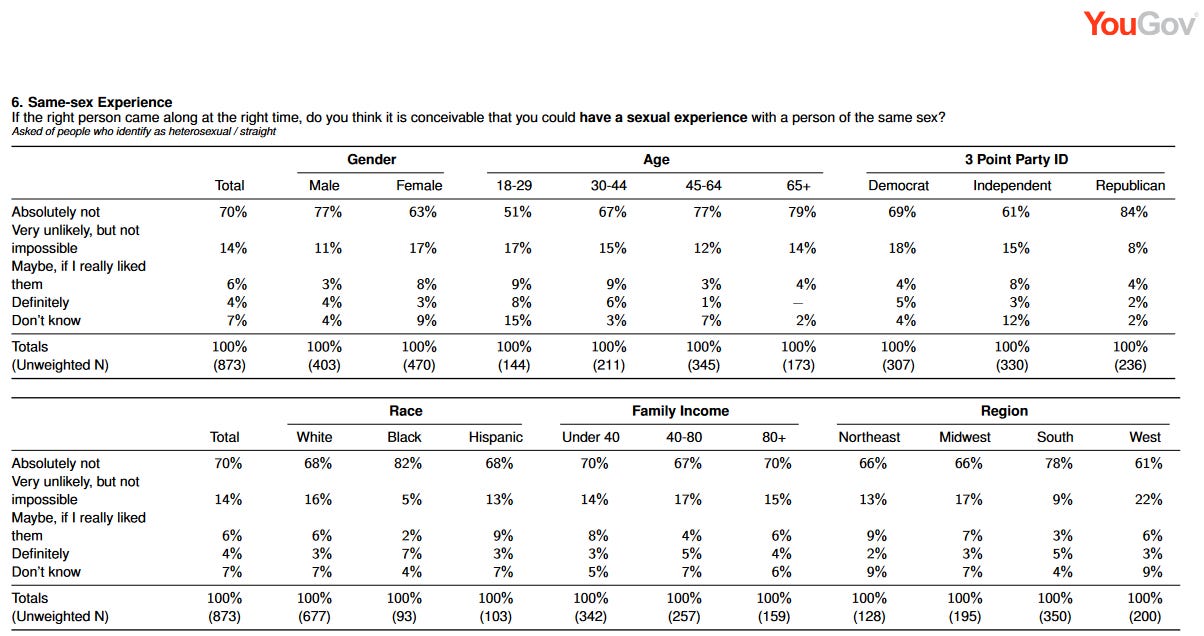Raise Your Threshold For Accusing People Of Faking Bisexuality
I.
Many comments in yesterday’s post about self-identified bisexuals getting long COVID centered on a concern that self-identified bisexuals don’t really date both sexes, and are just claiming to be bi because it’s trendy.
Bisexuals themselves hate this and have written many articles and papers about why you shouldn’t say it (1, 2, 3). But I especially appreciated a discussion in the comments between Nom de Flume, Ryan W, and others, giving a great statistical explanation for why it’s tempting to believe this, but why it isn’t true.
Suppose someone (let’s say a woman) has exactly equal sexual attraction to both men and women.
Their male dating pool is all heterosexual and bisexual men (95%+ of men), and their female dating pool is all lesbian and bisexual women (about 5-10% of women). So their potential dating pool is about 90% male. So this “perfectly” bisexual woman could be expected to date about 10x as many men as women, just by numbers alone.
The average person dates about seven people before marriage (yes, this seems low to me too). So if our bisexual woman samples exactly evenly from her male vs. female dating pool, we would expect about a 50-50 chance (0.90^7 = 0.478) that all seven of her relationships would be with men.
But actually there are many more reasons we should expect her to date more men than women.
-
Some families/communities/areas stigmatize homosexuality, and even though this is getting better, even a little stigma is a good reason to avoid homosexual relationships when you could have a straight relationship just as easily.
-
If you want to have biological children with your partner, you need them to be opposite-sex (for now!)
-
Men are socialized to proactively ask women out; women are socialized to wait to be asked out. If everyone follows their social script, a bisexual woman will wait to be asked out, and the only people who ask her out will be men.
-
It’s harder to ask someone of the same sex out, because unless they’ve already signaled they’re gay, they’ll probably be straight and say no, and they might even be confused/offended.
-
And - this is something I’ve heard from all the bisexual women I’ve talked to - getting dates with men is easy, because men are horny and desperate and often ask women out; getting dates with women is hard, for the usual reasons that every heterosexual man already viscerally appreciates.
So we should expect that, of women who are exactly equally interested in men vs. women, most of them will never have a relationship with a woman in their life.
Here’s the results of a study on what percent of bisexual women have had only male partners in five years (source):
This probably requires some adjustments - more people under 30 are LGBT, so bisexuals have a bigger same-sex dating pool, But also, five years is shorter than a lifetime. Overall I think its numbers are pretty consistent with the story above.1
II.
Can we just check and see what percent of people are equally aroused by men vs. women? Sex researchers have done something kind of like this by showing people porn and monitoring genital arousal. If I understand right, the closest thing to a consensus is that self-identified straight men and gay men are aroused by women and men respectively, self-identified bisexual men are probably aroused by both men and women although there are big fights about this, and approximately all women are aroused by both sexes except maybe some lesbians.
 (source)
(source)
I can’t directly find good numbers for what percent of men have a bisexual arousal pattern. This study seems to cross-validate Kinsey scales and penile arousal, and on this poll with a Kinsey like question, about 8-10% of men have scores that would put them in the bisexual range (although there are more gays than other polls, so this might be an unusually LGBTQ sample). But the poll also shows very few women putting themselves in the bisexual range. I guess nobody ever claimed to have cross-validated Kinsey scales and genital arousal in women, so maybe this doesn’t cast doubt on the male result.2
The poll (from the USA in 2015) also asks more specific questions, which suggest that even though women are (were?) just less likely to describe themselves as straight, while being more interested in same-sex relationships:
III.
I think these data support the following picture:
About 10% of men, and 90%+ of women, can be sexually aroused by people of either sex. Most of them tune out the same-sex arousal and go through life honestly identifying as straight. Maybe they tune it out because of social conditioning, or because some other arousal system besides the genital one measured here is guiding their emotions.
But other people don’t tune it out - either because they have stronger same-sex attraction, or because social conditioning affects them less, or because they’re more introspective and worse at tuning things out. Some of these people take it seriously enough to self-identify as bisexual; others don’t.
Most people who notice their bisexual attraction pattern and identify as bisexual will rarely or never date anyone of the same sex, mostly because of the size of the dating pools, but also for reasons of social convenience.
So getting back to the original question: are more people identifying as bisexual now because of trendiness? The answer isn’t exactly “no”, but I would frame it differently. Most women, and some men, have brains compatible with attraction to either sex - plus some other factor (maybe social conditioning) that prevents them from noticing this. As bisexuality becomes more accepted (“trendier”), there’s less social conditioning, and more people notice. Most of these people will never date anyone of the same sex, because it’s hard, and there’s no particular reason to.
Does this mean these people shouldn’t identify as bisexual? This is a definitional-boundary-drawing question, not a factual one. But my definitional-boundary-drawing answer is that before identities were scrip that could be exchanged for trendiness points, they were signals that other people could use to decipher to determine how to interact with you. “Bisexual” meant “if you ask me out on a date, I might say yes, regardless of which sex you are”. If we imagine the person I mentioned above - a woman who would be happy to date other women, but none of them have ever asked her out - “bisexual” sends the right signal to her potential dating partners.
(I had an acquaintance who mostly dated women and described herself as a lesbian. Then a mutual friend told me that this acquaintance liked me, and that I had totally missed this, and I needed to ask her on a date. I was confused: wasn’t she a lesbian? My friend explained that the acquaintance was mostly lesbian but a little bisexual and it hadn’t come up before. This distinction ended up being very important to me, and I don’t know who it serves to encourage people to hide it.)3
Finally, what does this mean for the original Long COVID question?
I find myself intrigued by Mike’s explanation: if many people are bisexual but just don’t notice it, bisexuality might correlate with increased awareness of one’s own mental state and unwillingness to round it off to socially acceptable alternatives. If lots of people get Long COVID in the sense of some mild fatigue on the threshold of awareness, maybe people who are good at noticing their mental state and not rounding it off to something else are more likely to notice that.
I don’t think this is quite right: Long COVID also correlates with pretty much every mental illness, and it correlates more with psychiatrist-diagnosed illnesses than self-diagnosed ones, so I think that provides extra evidence that it is a neurodivergence effect, which is also sufficient to explain the bisexuality effect. My (completely unfounded) guess is that neurodivergent people are more susceptible to state-fixation disorders, where a temporary state (like the fatigue and weakness of having COVID) becomes the nervous system’s new normal for some reason (cf. discussion of chronic pain, HPPD, etc at Part IV here).
This is wild conjecture - I’m only bringing it up because your wild conjectures in the comments were much worse.
-
That is, things look about how they would look if most self-identified bisexuals were about equally attracted to men and women. I don’t know if this is literally true. I think it’s also possible that there are more people with 75% opposite-sex, 25% same sex attraction than vice versa (because most people are straight, and so there are more people who are approximately-straight-but-flexible than people who are approximately-gay-but-flexible), but that bisexuals sometimes actively seek out people from the same sex for novelty reasons, or because heterosexuality is the default and so it takes a higher level of homosexual than heterosexual attraction to even identify as bisexual. There are a lot of things that could be going on here. But the data don’t rule out that bisexuals average 50-50.
-
I can’t find a specific citation for it, but many of these studies seem to talk as if bisexual men are mostly gay but can kind of be attracted to women sometimes, and bisexual women are more mixed. I don’t know if this is an unfair stereotype or if somebody’s validated it somewhere.
-
Also, as a straight person, I want to protect the signaling value of the word “straight”. Right now I have a pretty good deal where I can self-describe as straight and guys won’t hit on me. If 5% of straight guys would say yes to being hit on by a man, men would hit on us much more often. So it’s in my self-interest for men who might like men to self-ID as bisexual, even if they like women more, or they rarely act on their same-sex attraction.


